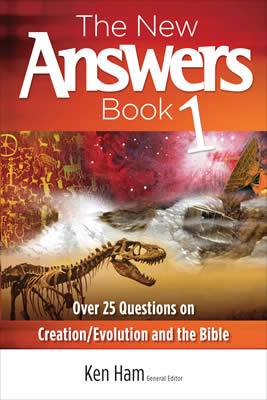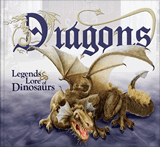
Chapter 12
What Really Happened to the Dinosaurs?
The Bible gives us a framework for explaining dinosaurs in terms of thousands of years of history, including the mystery of when they lived and what happened to them.
Dinosaurs are used more than almost anything else to indoctrinate children and adults in the idea of millions of years of earth history. However, the Bible gives us a framework for explaining dinosaurs in terms of thousands of years of history, including the mystery of when they lived and what happened to them. Two key texts are Genesis 1:24–25 and Job 40:15–24.
Are Dinosaurs a Mystery?
Many think that the existence of dinosaurs and their demise is shrouded in such mystery that we may never know the truth about where they came from, when they lived, and what happened to them. However, dinosaurs are only a mystery if you accept the evolutionary story of their history.
According to evolutionists: Dinosaurs first evolved around 235 million years ago, long before man evolved.1 No human being ever lived with dinosaurs. Their history is recorded in the fossil layers on earth, which were deposited over millions of years. They were so successful as a group of animals that they eventually ruled the earth. However, around 65 million years ago, something happened to change all of this—the dinosaurs disappeared. Most evolutionists believe some sort of cataclysmic event, such as an asteroid impact, killed them. But many evolutionists claim that some dinosaurs evolved into birds, and thus they are not extinct but are flying around us even today.2
There is no mystery surrounding dinosaurs if you accept the Bible’s totally different account of dinosaur history.
According to the Bible: Dinosaurs first existed around 6,000 years ago.3 God made the dinosaurs, along with the other land animals, on Day 6 of the Creation Week (Genesis 1:20–25, 31). Adam and Eve were also made on Day 6—so dinosaurs lived at the same time as people, not separated by eons of time.

Dinosaurs could not have died out before people appeared because dinosaurs had not previously existed; and death, bloodshed, disease, and suffering are a result of Adam’s sin (Genesis 1:29–30; Romans 5:12, 14; 1 Corinthians 15:21–22).

Representatives of all the kinds of air-breathing land animals, including the dinosaur kinds, went aboard Noah’s Ark. All those left outside the Ark died in the cataclysmic circumstances of the Flood, and many of their remains became fossils.

After the Flood, around 4,300 years ago, the remnant of the land animals, including dinosaurs, came off the Ark and lived in the present world, along with people. Because of sin, the judgments of the Curse and the Flood have greatly changed earth. Post-Flood climatic change, lack of food, disease, and man’s activities caused many types of animals to become extinct. The dinosaurs, like many other creatures, died out. Why the big mystery about dinosaurs?
Why Such Different Views?
How can there be such totally different explanations for dinosaurs? Whether one is an evolutionist or accepts the Bible’s account of history, the evidence for dinosaurs is the same. All scientists have the same facts—they have the same world, the same fossils, the same living creatures, the same universe.
If the “facts” are the same, then how can the explanations be so different? The reason is that scientists have only the present—dinosaur fossils exist only in the present—but scientists are trying to connect the fossils in the present to the past. They ask, “What happened in history to bring dinosaurs into existence, wipe them out, and leave many of them fossilized?”4
The science that addresses such issues is known as historical or origins science, and it differs from the operational science that gives us computers, inexpensive food, space exploration, electricity, and the like. Origins science deals with the past, which is not accessible to direct experimentation, whereas operational science deals with how the world works in the here and now, which, of course, is open to repeatable experiments. Because of difficulties in reconstructing the past, those who study fossils (paleontologists) have diverse views on dinosaurs.5 As has been said, “Paleontology (the study of fossils) is much like politics: passions run high, and it’s easy to draw very different conclusions from the same set of facts.”6
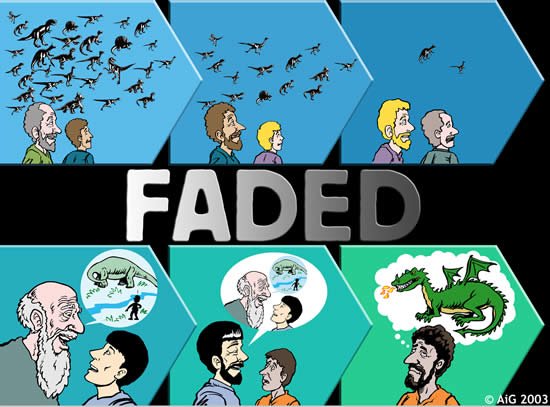
A paleontologist who believes the record in the Bible, which claims to be the Word of God,7 will come to different conclusions than an atheist who rejects the Bible. Willful denial of God’s Word (2 Peter 3:3–7) lies at the root of many disputes over historical science.
Many people think the Bible is just a book about religion or salvation. It is much more than this. The Bible is the History Book of the Universe and tells us the future destiny of the universe as well. It gives us an account of when time began, the main events of history, such as the entrance of sin and death into the world, the time when the whole surface of the globe was destroyed by water, the giving of different languages at the Tower of Babel, the account of the Son of God coming as a man, His death and Resurrection, and the new heavens and earth to come.

Ultimately, there are only two ways of thinking: starting with the revelation from God (the Bible) as foundational to all thinking (including biology, history, and geology), resulting in a Christian worldview; or starting with man’s beliefs (for example, the evolutionary story) as foundational to all thinking, resulting in a secular worldview.
Most Christians have been indoctrinated through the media and education system to think in a secular way. They tend to take secular thinking to the Bible, instead of using the Bible to build their thinking (Romans 12:1–2; Ephesians 4:20–24).
The Bible says, “The fear of the Lord is the beginning of knowledge” (Proverbs 1:7) and “the fear of the Lord is the beginning of wisdom” (Proverbs 9:10).
If one begins with an evolutionary view of history (for which there were no witnesses or written record), then this way of thinking will be used to explain the evidence that exists in the present. Thus, we have the evolutionary explanation for dinosaurs above.
But if one begins with the biblical view of history from the written record of an eyewitness (God) to all events of history, then a totally different way of thinking, based on this, will be used to explain the same evidence. Thus, we have the biblical explanation given above.
Dinosaur History
Fossil bones of dinosaurs are found around the world. Many of these finds consist of just fragments of bones, but some nearly complete skeletons have been found. Scientists have been able to describe many different types of dinosaurs based on distinctive characteristics, such as the structure of the skull and limbs.8
Where Did Dinosaurs Come From?
The Bible tells us that God created different kinds of land animals on Day 6 of Creation Week (Genesis 1:24–25). Because dinosaurs were land animals, this must have included the dinosaur kinds.9
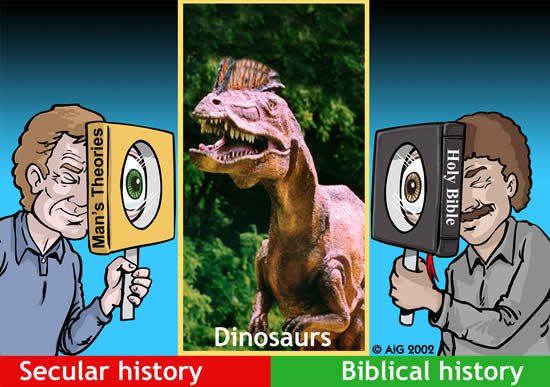
Evolutionists claim that dinosaurs evolved from some reptile that had originally evolved from amphibians. But they cannot point to any clear transitional (in-between) forms to substantiate their argument. Dinosaur family trees in evolutionary books show many distinct types of dinosaurs, but only hypothetical lines join them up to some common ancestor. The lines are dotted because there is no fossil evidence. Evolutionists simply cannot prove their belief in a nondinosaur ancestor for dinosaurs.
What Did Dinosaurs Look Like?
Scientists generally do not dig up a dinosaur with all its flesh intact. Even if they found all the bones, they still would have less than 40 percent of the animal to work out what it originally looked like. The bones do not tell the color of the animal, for example, although some fossils of skin impressions have been found, indicating the skin texture. As there is some diversity of color among reptiles living today, dinosaurs may have varied greatly in color, skin texture, and so on.
When reconstructing dinosaurs from bony remains, scientists make all kinds of guesses and often disagree.
When reconstructing dinosaurs from bony remains, scientists make all kinds of guesses and often disagree. For example, debate has raged about whether dinosaurs were warm- or cold-blooded. It is even difficult to tell whether a dinosaur was male or female from its bones. There is much speculation about such things.
Sometimes scientists make mistakes in their reconstructions, which need correction when more bones are found. For instance, the original “discoverer” of Brontosaurus put the wrong head on a skeleton of this dinosaur.10
Who Discovered Dinosaurs?
Secular books would tell you that the first discovery of what later were called dinosaurs was in 1677 when Dr. Robert Plot found bones so big they were thought to belong to a giant elephant or a giant human.11
In 1822, Mary Anne Mantell went for a walk along a country road in Sussex, England. According to tradition, she found a stone that glittered in the sunlight and showed it to her fossil-collecting husband. Dr. Mantell, a physician, noticed that the stone contained a tooth similar to, but much larger than, that of modern reptiles. He concluded that it belonged to some extinct giant plant-eating reptile with teeth like an iguana. In 1825 he named the owner of the tooth Iguanodon (iguana tooth). It was Dr. Mantell who began to popularize the “age of reptiles.”12
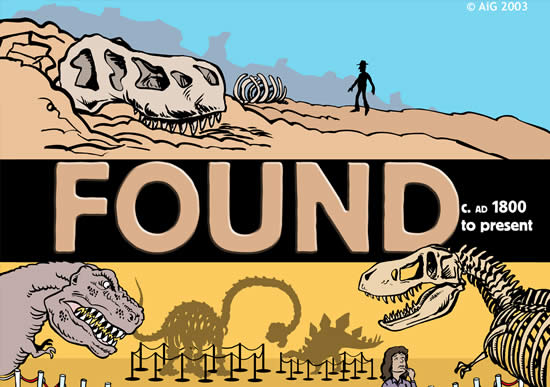
From a biblical perspective, however, the time of the above discoveries was actually the time when dinosaurs were rediscovered. Adam discovered dinosaurs when he first observed them.
When Did Dinosaurs Live?
Evolutionists claim dinosaurs lived millions of years ago. But it is important to realize that when they dig up a dinosaur bone it does not have a label attached showing its date. Evolutionists obtain their dates by indirect dating methods that other scientists question, and there is much evidence against the millions of years.13
Does God tell us when He made Tyrannosaurus rex? Many would say no. But the Bible states that God made all things in six normal days. He made the land animals, including dinosaurs, on Day 6 (Genesis 1:24–25), so they date from around 6,000 years ago—the approximate date of creation obtained by adding up the years in the Bible.14 So, since T. rex was a land animal and God made all the land animals on Day 6, then God made T. rex (or the original Tyrannosaurid kind) on Day 6.

Furthermore, from the Bible we see that there was no death, bloodshed, disease, or suffering before sin.15 If one approaches Genesis to Revelation consistently, interpreting Scripture with Scripture, then death and bloodshed of man and animals came into the world only after Adam sinned. The first death of an animal occurred when God shed an animal’s blood in the Garden of Eden and clothed Adam and Eve (Genesis 3:21). This was also a picture of the Atonement—foreshadowing Christ’s blood that was to be shed for us. Thus, there could not have been bones of dead animals before sin—this would undermine the gospel.
This means that the dinosaurs must have died after sin entered the world, not before. Dinosaur bones could not be millions of years old because Adam lived only thousands of years ago.
Does the Bible Mention Dinosaurs?
If people saw dinosaurs, you would think that ancient historical writings, such as the Bible, should mention them. The King James Version was first translated in 1611.16 Some people think that because the word “dinosaur” is not found in this or other translations, the Bible does not mention dinosaurs.

It was not until 1841, however, that the word “dinosaur” was invented.17 Sir Richard Owen, a famous British anatomist and first superintendent of the British Museum (and a staunch anti-Darwinist), on viewing the bones of Iguanodon and Megalosaurus, realized these represented a unique group of reptiles that had not yet been classified. He coined the term “dinosaur” from Greek words meaning “terrible lizard.”18
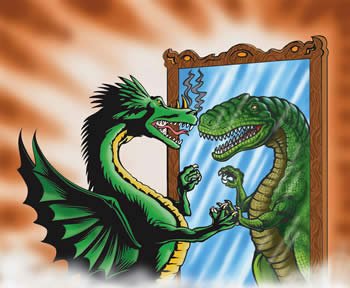
Thus, one would not expect to find the word “dinosaur” in the King James Bible—the word did not exist when the translation was done.
Is there another word for “dinosaur”? There are dragon legends from around the world. Many dragon descriptions fit the characteristics of specific dinosaurs. Could these actually be accounts of encounters with what we now call dinosaurs?
Just as Flood legends are based on a real global Flood (Flood of Noah)— dragon legends are possibly based on actual encounters with real animals that today we call dinosaurs. Many of these land-dragon descriptions do fit with what we know about dinosaurs.
In Genesis 1:21 (NAS), the Bible says, “And God created the great sea monsters and every living creature that moves, with which the waters swarmed, after their kind.” The Hebrew word here for “sea monsters” (“whales” in KJV) is the word translated elsewhere as “dragon” (Hebrew: tannin). So, in the first chapter of the first book of the Bible, God may be describing the great sea dragons (sea-dwelling, dinosaur-type animals) that He created.
There are other Bible passages about dragons that lived in the sea: “the dragons in the waters” (Psalm 74:13 KJV), “and he shall slay the dragon that is in the sea” (Isaiah 27:1 KJV). Though the word “dinosaur” strictly refers to animals that lived on the land, the sea reptiles and flying reptiles are often grouped with the dinosaurs. The sea dragons could have included dinosaur-type animals such as the Mosasaurus.19
Job 41 describes a great animal that lived in the sea, Leviathan, that even breathed fire. This “dragon” may have been something like the mighty 40 ft. (12 m) Sarcosuchus imperator (Super Croc),20 or the 82 ft. (25 m) Liopleurodon.
There is also mention of a flying serpent in the Bible: the “fiery flying serpent” (Isaiah 30:6). This could be a reference to one of the pterodactyls, which are popularly thought of as flying dinosaurs, such as the Pteranodon, Rhamphorhynchus, or Ornithocheirus.21
Not long after the Flood, God was showing a man called Job how great He was as Creator, by reminding Job of the largest land animal He had made:
Look now at the behemoth, which I made along with you; he eats grass like an ox. See now, his strength is in his hips, and his power is in his stomach muscles. He moves his tail like a cedar; the sinews of his thighs are tightly knit. His bones are like beams of bronze, his ribs like bars of iron. He is the first of the ways of God; only He who made him can bring near His sword (Job 40:15–19 NKJV).
The phrase “first of the ways of God” suggests this was the largest land animal God had made. So what kind of animal was “behemoth”?
Bible translators, not being sure what this beast was, often transliterated the Hebrew, and thus the word behemoth (e.g., KJV, NKJV, NASB, NIV). However, in many Bible commentaries and Bible footnotes, “behemoth” is said to be “possibly the hippopotamus or elephant.”22 Some Bible versions actually translate “behemoth” this way.23 Besides the fact that the elephant and hippo were not the largest land animals God made (some of the dinosaurs far eclipsed these), this description does not make sense, since the tail of behemoth is compared to the large cedar tree (verse 17).
Now an elephant’s tiny tail (or a hippo’s tail that looks like a flap of skin) is quite unlike a cedar tree. Clearly, the elephant and the hippo could not possibly be “behemoth.”
No living creature comes close to this description. However, behemoth is very much like Brachiosaurus, one of the large dinosaurs.
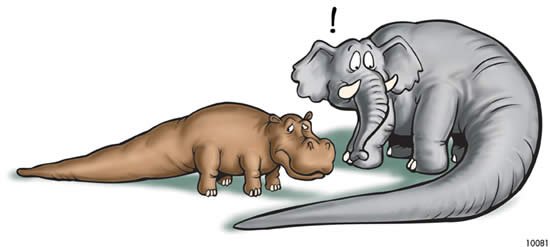
Are There Other Ancient Records of Dinosaurs?
In the film The Great Dinosaur Mystery,24 a number of dragon accounts are presented:
- A Sumerian story dating back to 2000 BC or earlier tells of a hero named Gilgamesh, who, when he went to fell cedars in a remote forest, encountered a huge vicious dragon that he slew, cutting off its head as a trophy.
- When Alexander the Great (c. 330 BC) and his soldiers marched into India, they found that the Indians worshipped huge hissing reptiles that they kept in caves.
- China is renowned for its dragon stories, and dragons are prominent on Chinese pottery, embroidery, and carvings.
- England and several other cultures retain the story of St. George, who slew a dragon that lived in a cave.
- There is the story of a tenth-century Irishman who wrote of his encounter with what appears to have been a Stegosaurus.
- In the 1500s, a European scientific book, Historia Animalium, listed several living animals that we would call dinosaurs. A well-known naturalist of the time, Ulysses Aldrovandus, recorded an encounter between a peasant named Baptista and a dragon whose description fits that of the small dinosaur Tanystropheus. The encounter was on May 13, 1572, near Bologna in Italy, and the peasant killed the dragon.
Petroglyphs (drawings carved on rock) of dinosaur-like creatures have also been found.25
In summary, people down through the ages have been very familiar with dragons. The descriptions of these animals fit with what we know about dinosaurs. The Bible mentions such creatures, even ones that lived in the sea and flew in the air. There is a tremendous amount of other historical evidence that such creatures have lived beside people.
What Do the Bones Say?
There is also physical evidence that dinosaur bones are not millions of years old. Scientists from Montana State University found T. rex bones that were not totally fossilized. Sections of the bones were like fresh bone and contained what seems to be blood cells and hemoglobin. If these bones really were tens of millions of years old, then the blood cells and hemoglobin would have totally disintegrated.26 Also, there should not be “fresh” bones if they were really millions of years old.27 A report by these scientists stated the following:
A thin slice of T. rex bone glowed amber beneath the lens of my microscope . . . . The lab filled with murmurs of amazement, for I had focused on something inside the vessels that none of us had ever noticed before: tiny round objects, translucent red with a dark center . . . . Red blood cells? The shape and location suggested them, but blood cells are mostly water and couldn’t possibly have stayed preserved in the 65-million-year-old tyrannosaur . . . . The bone sample that had us so excited came from a beautiful, nearly complete specimen of Tyrannosaurus rex unearthed in 1990 . . . . When the team brought the dinosaur into the lab, we noticed that some parts deep inside the long bone of the leg had not completely fossilized . . . . So far, we think that all of this evidence supports the notion that our slices of T. rex could contain preserved heme and hemoglobin fragments. But more work needs to be done before we are confident enough to come right out and say, “Yes, this T. rex has blood compounds left in its tissues.”28
Unfossilized duck-billed dinosaur bones have been found on the North Slope in Alaska.29 Also, creation scientists collected such (unfossilized) frozen dinosaur bones in Alaska.30 Evolutionists would not say that these bones had stayed frozen for the many millions of years since these dinosaurs supposedly died out (according to evolutionary theory). Yet the bones could not have survived for the millions of years unmineralized. This is a puzzle to those who believe in an “age of dinosaurs” millions of years ago, but not to someone who builds his thinking on the Bible.
What Did Dinosaurs Eat and How Did They Behave?
Movies like Jurassic Park and The Lost World portray most dinosaurs as aggressive meat-eaters. But the mere presence of sharp teeth does not tell you how an animal behaved or necessarily what food it ate—only what kind of teeth it had (for ripping food and the like). However, by studying fossil dinosaur dung (coprolite), scientists have been able to determine the diet of some dinosaurs.31
Originally, before sin, all animals, including the dinosaurs, were vegetarian. Genesis 1:30 states, “And to every beast of the earth, and to every bird of the air, and to every thing that creeps upon the earth, which has life, I have given every green herb for food: and it was so.”
This means that even T. rex, before sin entered the world, ate only plants. Some people object to this by pointing to the big teeth that a large T. rex had, insisting they must have been used for attacking animals. However, just because an animal has big, sharp teeth does not mean it eats meat. It just means it has big, sharp teeth!32
Many animals today have sharp teeth but are basically vegetarian.
Many animals today have sharp teeth but are basically vegetarian. The giant panda has sharp teeth like a meat-eater’s, but it eats bamboo. Perhaps the panda’s teeth were beautifully designed to eat bamboo. To explain why a giant panda has teeth like a meat-eaters today, yet eats bamboo, evolutionists have to say that the giant panda evolved as a meat-eater, and then switched to bamboo.33
Different species of bats variously eat fruit, nectar, insects, small animals, and blood, but their teeth do not clearly indicate what they eat.34 Bears have teeth with carnivore features, but some bears are vegetarian, and many, if not most, are mainly vegetarian.
Before sin, God described the world as “very good” (Genesis 1:31). Some cannot accept this concept of perfect harmony because of the food chain that they observe in today’s world. However, one cannot look at the sin-cursed world with the resultant death and struggle and use this to reject the Genesis account of history. Everything has changed because of sin. That’s why Paul describes the present creation as “groaning” (Romans 8:22). One must look through the Bible’s “eyes” to understand the world.35
Some argue that people or animals would have been hurt even in an ideal world. They contend that even before sin, Adam or an animal could have stood on small creatures or scratched himself on a branch. Now these sorts of situations are true of today’s fallen world—the present world is not perfect; it is suffering from the effects of the Curse (Romans 8:22). One cannot look at the Bible through the world’s eyes and insist that the world before sin was just like the world we see today. We do not know what a perfect world, continually restored and totally upheld by God’s power (Colossians 1:17; Hebrews 1:3), would have been like—we have never experienced perfection (only Adam and Eve did before sin).
We do get little glimpses from Scripture, however; in Deuteronomy 8:4, 29:5 and Nehemiah 9:21, we are told that when the Israelites wandered in the desert for 40 years, their clothes and shoes did not wear out, nor did their feet swell. When God upholds things perfectly, wearing out or being hurt in any way is not even an option.
Think of Shadrach, Meshach, and Abednego (Daniel 3:26–27). They came out of the fire without even the smell of smoke on them. Again, when the Lord upholds perfectly, being hurt is not possible. In a perfect world, before sin and the Curse, God would have upheld everything, but in this cursed world, things run down. Many commentators believe the description in Isaiah 11:6–9 of the wolf and lamb, and the lion that eats straw like an ox, is a picture of the new earth in the future restoration (Acts 3:21) when there will be no more curse or death (Revelation 21:1, 22:3). The animals described are living peacefully as vegetarians (this is also the description of the animal world before sin—Genesis 1:30). Today’s world has been changed dramatically because of sin and the Curse. The present food chain and animal behavior (which also changed after the Flood—Genesis 9:2–3) cannot be used as a basis for interpreting the Bible—the Bible explains why the world is the way it is.
In the beginning, God gave Adam and Eve dominion over the animals: “Then God blessed them, and God said to them, ‘Be fruitful and multiply; fill the earth and subdue it; have dominion over the fish of the sea, over the birds of the air, and over every living thing that moves on the earth’” (Genesis 1:28 NKJV). Looking at today’s world, we are reminded of Hebrews 2:8 (NKJV): “For in that He put all in subjection under him, He left nothing that is not put under him. But now we do not yet see all things put under him.” Man’s relationship with all things changed because of sin—they are not “under him” as they were originally.
Most people, including most Christians, tend to observe the world as it is today, with all its death and suffering, and then take that observation to the Bible and interpret it in that light. But we are sinful, fallible human beings, observing a sin-cursed world (Romans 8:22); and thus, we need to start with divine revelation, the Bible, to begin to understand.
So how did fangs and claws come about? Dr. Henry Morris, a founding figure in the modern creation movement, states:
Whether such structures as fangs and claws were part of their original equipment, or were recessive features which only became dominant due to selection processes later, or were mutational features following the Curse, or exactly what, must await further research.36
After sin entered the world, everything changed. Maybe some animals started eating each other at this stage. By the time of Noah, God described what had happened this way: “So God looked upon the earth, and indeed it was corrupt; for all flesh had corrupted their way on the earth” (Genesis 6:12 NKJV).
Also, after the Flood, God changed the behavior of animals. We read, “And the fear of you and the dread of you shall be on every beast of the earth, on every bird of the air, on all that move on the earth, and on all the fish of the sea. They are given into your hand” (Genesis 9:2 NKJV). Thus, man would find it much more difficult to carry out the dominion mandate given in Genesis 1:28.
Why Do We Find Dinosaur Fossils?
Fossil formation requires a sudden burial. When an animal dies, it usually gets eaten or decays until there is nothing left. To form a fossil, unique conditions are required to preserve the animal and replace it with minerals, etc.
To form a fossil, unique conditions are required to preserve the animal and replace it with minerals, etc.
Evolutionists once claimed that the fossil record was formed slowly as animals died and were gradually covered by sediment. But they have acknowledged more recently that the fossil record must involve catastrophic processes.37 To form the billions of fossils worldwide, in layers sometimes kilometers thick, the organisms, by and large, must have been buried quickly. Many evolutionists now say the fossil record formed quickly, in spurts interspersed by millions of years.
According to the Bible, as time went on, earth became full of wickedness, so God determined that He would send a global Flood “to destroy from under heaven all flesh in which is the breath of life” (Genesis 6:17).
God commanded Noah to build a very large boat into which he would take his family and representatives of every kind of land-dwelling, air-breathing animal (that God Himself would choose and send to Noah, Genesis 6:20). This must have included two of each kind of dinosaur.
How Did Dinosaurs Fit on the Ark?
Many people think of dinosaurs as large creatures that would never have fit into the Ark.
But the average size of a dinosaur, based on the skeletons found over the earth, is about the size of a large sheep or bison.38 Indeed, many dinosaurs were relatively small. For instance, Struthiomimus was the size of an ostrich, and Compsognathus was no bigger than a rooster. Only a few dinosaurs grew to extremely large sizes (e.g., Brachiosaurus and Apatosaurus), but even they were not as large as the largest animal in the world today, the blue whale. (Reptiles have the potential to grow as long as they live. Thus, the large dinosaurs were probably very old ones.)
It is realistic to assume that God would have sent young adults to the Ark, not fully grown creatures.
Dinosaurs laid eggs, and the biggest fossil dinosaur egg found is about the size of a football.39 Even the largest dinosaurs were very small when first hatched. Remember that the animals that came off the boat were to repopulate the earth. Thus, it would have been necessary to choose young adults, which would soon be in the prime of their reproductive life, to go on the Ark. Recent research suggests that dinosaurs underwent rapid adolescent growth spurts.40 So it is realistic to assume that God would have sent young adults to the Ark, not fully grown creatures.
Some might argue that the 600 or more named species of dinosaurs could not have fit on the Ark. But Genesis 6:20 states that representative kinds of land animals boarded the Ark. The question then is, what is a “kind” (Hebrew: min)? Biblical creationists have pointed out that there can be many species descended from a kind. For example, there are many types of cats in the world, but all cat species probably came from one or only a few kinds of cats originally.41 The cat varieties today have developed by natural and artificial selection acting on the original variation in the information (genes) of the original cats. This has produced different combinations and subsets of information, and thus different types of cats.
Mutations (errors in copying of the genes during reproduction) can also contribute to the variation, but the changes caused by mutations are “downhill,” causing loss of the original information.
Even speciation could occur through these processes. This speciation is not “evolution,” since it is based on the created information already present and is thus a limited, downhill process, not involving an upward increase in complexity. Thus, only one or a few feline pairs would have been needed on Noah’s Ark.
Dinosaur names have tended to proliferate, with new names being given to just a few pieces of bone, even if the skeleton looks similar to one that is a different size or found in a different country. There were probably fewer than 50 distinct groups or kinds of dinosaurs that had to be on the Ark.42
Also, it must be remembered that Noah’s Ark was extremely large and quite capable of carrying the number of animals needed, including dinosaurs.
The land animals that were not on the Ark, including dinosaurs, drowned. Many were preserved in the layers formed by the Flood—thus the millions of fossils. Presumably, many of the dinosaur fossils were buried at this time, around 4,500 years ago. Also, after the Flood, there would have been considerable catastrophism, including such events as the Ice Age, resulting in some post-Flood formation of fossils, too.
The contorted shapes of these animals preserved in the rocks, the massive numbers of them in fossil graveyards, their wide distribution, and some whole skeletons, all provide convincing evidence that they were buried rapidly, testifying to massive flooding.43
Why Don’t We See Dinosaurs Today?
At the end of the Flood, Noah, his family, and the animals came out of the Ark (Genesis 8:15–17). The dinosaurs thus began a new life in a new world. Along with the other animals, the dinosaurs came out to breed and repopulate the earth. They would have left the landing place of the Ark and spread over the earth’s surface. The descendants of these dinosaurs gave rise to the dragon legends.
But the world they came out to repopulate differed from the one they knew before Noah’s Flood. The Flood had devastated it. It was now a much more difficult world in which to survive.
After the Flood, God told Noah that from then on, the animals would fear man, and that animal flesh could be food for man (Genesis 9:1–7). Even for man, the world had become a harsher place. To survive, the once easily obtained plant nutrition would now have to be supplemented by animal sources.
Both animals and man would find their ability to survive tested to the utmost. We can see from the fossil record, from the written history of man, and from experience over recent centuries that many forms of life on this planet have not survived that test.
We need to remember that many plants and air-breathing, land-dwelling animals have become extinct since the Flood—either due to man’s action or competition with other species or because of the harsher post-Flood environment. Many groups are still becoming extinct. Dinosaurs seem to be numbered among the extinct groups.
Why then are people so intrigued about dinosaurs and have little interest in the extinction of the fern Cladophebius, for example? It’s the dinosaurs’ appeal as monsters that excites and fascinates people.
Evolutionists have capitalized on this fascination, and the world is awash with evolutionary propaganda centered on dinosaurs. As a result, evolutionary philosophy has permeated modern thinking, even among Christians.
If you were to ask the zoo why they have endangered species programs, you would probably get an answer something like this: “We’ve lost lots of animals from this earth. Animals are becoming extinct all the time. Look at all the animals that are gone forever. We need to act to save the animals.” If you then asked, “Why are animals becoming extinct?” you might get an answer like this: “It’s obvious! People killing them, lack of food, man destroying the environment, diseases, genetic problems, catastrophes like floods—there are lots of reasons.”
The factors that cause extinction today . . . are the same factors that caused the dinosaurs to become extinct.
If you then asked, “Well, what happened to the dinosaurs?” the answer would probably be, “We don’t know! Scientists have suggested dozens of possible reasons, but it’s a mystery.”
Maybe one of the reasons dinosaurs are extinct is that we did not start our endangered species programs early enough. The factors that cause extinction today, which came about because of man’s sin—the Curse, the aftermath of the Flood (a judgment), etc.—are the same factors that caused the dinosaurs to become extinct.
Are Dinosaurs Really Extinct?
One cannot prove an organism is extinct without having knowledge of every part of the earth’s surface simultaneously. Experts have been embarrassed when, after having declared animals extinct, they were discovered alive and well. For example, in the 1990s explorers found elephants in Nepal that have many features of mammoths.44
Scientists in Australia found some living trees that they thought had become extinct with the dinosaurs. One scientist said, “It was like finding a ‘live dinosaur.’”45 When scientists find animals or plants that they thought were extinct long ago, they call them “living fossils.” There are hundreds of living fossils, a big embarrassment for those who believe in millions of years of earth history.
Explorers and natives in Africa have reported sighting dinosaur-like creatures, even in the twentieth century.46 These have usually been confined to out-of-the-way places such as lakes deep in the Congo jungles. Descriptions certainly fit those of dinosaurs.47
Cave paintings by native Americans seem to depict a dinosaur.48 Scientists accept the mammoth drawings in the cave, so why not the dinosaur drawings? Evolutionary indoctrination that man did not live at the same time as dinosaurs stops most scientists from even considering that the drawings are of dinosaurs.
It certainly would be no embarrassment to a creationist if someone discovered a dinosaur living in a jungle. However, this should embarrass evolutionists.
And no, we cannot clone a dinosaur, as in the movie Jurassic Park, even if we had dinosaur DNA. We would also need a living female dinosaur. Scientists have found that to clone an animal they need an egg of a living female, since “machinery” in the cytoplasm of her egg is necessary for the new creature to develop.49
Birdosaurs?
Many evolutionists do not really think dinosaurs are extinct anyway. In 1997, at the entrance to the bird exhibit at the zoo in Cincinnati, Ohio, we read the following on a sign:
Dinosaurs went extinct millions of years ago—or did they? No, birds are essentially modern short-tailed feathered dinosaurs.
In the mid-1960s, Dr. John Ostrom from Yale University began to popularize the idea that dinosaurs evolved into birds.50 However, not all evolutionists agree with this. “It’s just a fantasy of theirs,” says Alan Feduccia, an ornithologist at the University of North Carolina at Chapel Hill, and a leading critic of the dino-to-bird theory. “They so much want to see living dinosaurs that now they think they can study them vicariously at the backyard bird feeder.”51
There have been many attempts to indoctrinate the public to believe that modern birds are really dinosaurs. Time magazine, on April 26, 1993, had a front-page cover of a “birdosaur,” now called Mononykus, with feathers (a supposed transitional form between dinosaurs and birds) based on a fossil find that had no feathers.52 In the same month, Science News had an article suggesting this animal was a digging creature more like a mole.53
In 1996, newspapers reported a find in China of a reptile fossil that supposedly had feathers.54 Some of the media reports claimed that, if it were confirmed, it would be “irrefutable evidence that today’s birds evolved from dinosaurs.” One scientist stated, “You can’t come to any conclusion other than that they’re feathers.”55 However, in 1997 the Academy of Natural Sciences in Philadelphia sent four leading scientists to investigate this find. They concluded that they were not feathers. The media report stated, concerning one of the scientists, “He said he saw ‘hair-like’ structures—not hairs—that could have supported a frill, or crest, like those on iguanas.”56
No sooner had this report appeared than another media report claimed that 20 fragments of bones of a reptile found in South America showed that dinosaurs were related to birds.57
Birds are warm-blooded and reptiles are cold-blooded, but evolutionists who believe dinosaurs evolved into birds would like to see dinosaurs as warm-blooded to support their theory. But Dr. Larry Martin, of the University of Kansas, opposes this idea:
Recent research has shown the microscopic structure of dinosaur bones was “characteristic of cold-blooded animals,” Martin said. “So we’re back to cold-blooded dinosaurs.”58
Sadly, the secular media have become so blatant in their anti-Christian stand and pro-evolutionary propaganda that they are bold enough to make such ridiculous statements as, “Parrots and hummingbirds are also dinosaurs.”59
Several more recent reports have fueled the bird/dinosaur debate among evolutionists. One concerns research on the embryonic origins of the “fingers” of birds and dinosaurs, showing that birds could not have evolved from dinosaurs.60 A study of the so-called feathered dinosaur from China revealed that the dinosaur had a distinctively reptilian lung and diaphragm, which is distinctly different from the avian lung.61 Another report said that the frayed edges that some thought to be “feathers” on the Chinese fossil are similar to the collagen fibers found immediately beneath the skin of sea snakes.62
There is no credible evidence that dinosaurs evolved into birds.63 Dinosaurs have always been dinosaurs and birds have always been birds.
There is no credible evidence that dinosaurs evolved into birds.
What if a dinosaur fossil was found with feathers on it? Would that prove that birds evolved from dinosaurs? No, a duck has a duck bill and webbed feet, as does a platypus, but nobody believes that this proves that platypuses evolved from ducks. The belief that reptiles or dinosarus evolved into birds requires reptilian scales on the way to becoming feathers, that is, transitional scales, not fully formed feathers. A dinosaur-like fossil with feathers would just be another curious mosaic, like the platypus, and part of the pattern of similarities placed in creatures to show the hand of the one true Creator God who made everything.64
Why Does It Matter?
If they don’t believe the history in the Bible, why would anyone trust its moral aspects and message of salvation?
Although dinosaurs are fascinating, some readers may say, “Why are dinosaurs such a big deal? Surely there are many more important issues to deal with in today’s world, such as abortion, family breakdown, racism, promiscuity, dishonesty, homosexual behavior, euthanasia, suicide, lawlessness, pornography, and so on. In fact, we should be telling people about the gospel of Jesus Christ, not worrying about side issues like dinosaurs.”
Actually, the evolutionary teachings on dinosaurs that pervade society do have a great bearing on why many will not listen to the gospel, and thus why social problems abound today. If they don’t believe the history in the Bible, why would anyone trust its moral aspects and message of salvation?
If we accept the evolutionary teachings on dinosaurs, then we must accept that the Bible’s account of history is false. If the Bible is wrong in this area, then it is not the Word of God and we can ignore everything else it says that we find inconvenient.
If everything made itself through natural processes—without God—then God does not own us and has no right to tell us how to live. In fact, God does not really exist in this way of thinking, so there is no absolute basis for morality. Without God, anything goes—concepts of right and wrong are just a matter of opinion. And without a basis for morality, there is no such thing as sin. And no sin means that there is no need to fear God’s judgment and no need for the Savior, Jesus Christ. The history in the Bible is vital for properly understanding why one needs to accept Jesus Christ.
Millions of Years and the Gospel
The teaching that dinosaurs lived and died millions of years before man directly attacks the foundations of the gospel in another way. The fossil record, of which dinosaurs form a part, documents death, disease, suffering, cruelty, and brutality. It is a very ugly record. Allowing for millions of years in the fossil layers means accepting death, bloodshed, disease, and suffering before Adam’s sin.
But the Bible makes it clear that death, bloodshed, disease, and suffering are a consequence of sin. As part of the Curse, God told Adam in Genesis 3:19 that he would return to the dust from which he was made, showing that the sentence of death was not only spiritual but physical as well.
After Adam disobeyed God, the Lord clothed Adam and Eve with “coats of skins” (Genesis 3:21). To do this He must have killed and shed the blood of at least one animal. The reason for this can be summed up by Hebrews 9:22 (NKJV):
And according to the law almost all things are purified with blood, and without shedding of blood there is no remission.
God required the shedding of blood for the forgiveness of sins. What happened in the Garden of Eden was a picture of what was to come in Jesus Christ, who shed His blood on the Cross as “the Lamb of God, who takes away the sin of the world” (John 1:29).
If the shedding of blood occurred before sin, as would have happened if the garden was sitting on a fossil record of dead things millions of years old, then the foundation of the Atonement would be destroyed.
If the shedding of blood occurred before sin, as would have happened if the garden was sitting on a fossil record of dead things millions of years old, then the foundation of the Atonement would be destroyed.
This big picture also fits with Romans 8, which says that the whole creation “groans” because of the effects of the Fall of Adam—it was not “groaning” with death and suffering before Adam sinned. Jesus Christ suffered physical death and shed His blood because death was the penalty for sin. Paul discusses this in detail in Romans 5 and 1 Corinthians 15.
Revelation chapters 21 and 22 make it clear that there will be a “new heaven and a new earth” one day where there will be “no more death” and “no more curse”—just as it was before sin changed everything. Obviously, if there are going to be animals in the new earth, they will not die or eat each other or eat the redeemed people.
Thus, the teaching of millions of years of death, disease, and suffering before Adam sinned is a direct attack on the foundation of the message of the Cross.
Conclusion
If we accept God’s Word, beginning with Genesis, as being true and authoritative, then we can explain dinosaurs and make sense of the evidence we observe in the world around us. In doing this, we are helping people see that Genesis is absolutely trustworthy, logically defensible, and what it claims to be—the true account of the history of the universe and mankind. And what one believes concerning the book of Genesis will ultimately determine what one believes about the rest of the Bible. This, in turn, will affect how a person views himself or herself, fellow human beings, and what life is all about, including their need for salvation.
Related Videos
What Really Happened to the Dinosaurs?
The New Answers Book 1
The New Answers Book 1 is packed with biblical answers to over 25 of the most important questions on creation/evolution and the Bible.
Read Online Buy BookFootnotes
- J. Horner and D. Lessem, The Complete T. Rex, Simon & Schuster, New York, 1993, 18; M. Norell, E. Gaffney, and L. Dingus, Discovering Dinosaurs in the American Museum of Natural History, Nevraumont Publ., New York, 1995, 17, says that the oldest dinosaur fossil is dated at 228 million years.
- D. Gish, Evolution: the Fossils Still Say No! Institute for Creation Research, El Cajon, California, 1995, 129ff, discusses evolutionists’ views from a creationist position; Norell et al., Discovering Dinosaurs in the American Museum of Natural History, 2: “Dinosaurs belong to a group called Archosauria . . . . The living Archosauria are the twenty-one extant crocodiles and alligators, along with the more than ten thousand species of living theropod dinosaurs (birds).”
- J. Morris, The Young Earth, Master Books, Green Forest, Arkansas, 1994; H. Morris, The Genesis Record, Baker Book House, Grand Rapids, Michigan, 1976, 42–46. On the biblical chronology, see J. Ussher, The Annals of the World, Master Books, Green Forest, Arkansas, 2003; original published in 1658.
- M. Benton, Dinosaurs: An A–Z Guide, Derrydale Books, New York, 1988, 10–11.
- Benton, Dinosaurs: An A–Z Guide. See also D. Lambert and the Diagram Group, The Dinosaur Data Book, Avon Books, New York, 1990, 10–35; Norell et al., Discovering Dinosaurs in the American Museum of Natural History, 62–69; V. Sharpton and P. Ward, Eds., Global Catastrophes in Earth History, The Geological Society of America, Special Paper 247, 1990.
- M. Lemonick, “Parenthood, dino-style,” Time, p. 48, January 8, 1996.
- Psalm 78:5; 2 Timothy 3:14–17; and 2 Peter 1:19–21. God, who inspired the writing, has always existed, is perfect, and never lies (Titus 1:2).
- D. Lambert, A Field Guide to Dinosaurs, Avon Books, New York, 1983, 17.
- If some dinosaurs were aquatic, then these would have been created on Day 5 of Creation Week.
- “Yale Brontosaurus Gets Head on Right at Last,” The New York Times, October 26, 1981, https://www.nytimes.com/1981/10/26/nyregion/yale-brontosaurus-gets-head-on-right-at-last.html. See also Brontosaurus: The Only Dino to Go Extinct Twice.
- Benton, Dinosaurs: An A-Z Guide, 14.
- Lambert et al., The Dinosaur Data Book, 279.
- Morris, The Young Earth, 51–67.
- Morris, The Genesis Record, 44–46.
- J. Stambaugh, “Creation, suffering and the problem of evil,” CEN Technical Journal 10(3):391–404, 1996.
- The KJV most often used today is actually the 1769 revision by Benjamin Blayney of Oxford.
- D. Dixon et al., The Macmillan Illustrated Encyclopedia of Dinosaurs and Prehistoric Animals, Macmillan Publishing Co., New York, 1998, 92; R. Grigg, “Dinosaurs and dragons: stamping on the legends!” Creation, 14(3):11, 1990.
- D. Norman, The Illustrated Encyclopedia of Dinosaurs, Salamander Books Limited, London, 1985, 8. The meaning of “terrible lizard” has helped popularize the idea that dinosaurs were all gigantic savage monsters. This is far from the truth. Had Owen known about the smaller dinosaurs, he may never have coined the word.
- The Hebrew words have a range of meanings, including “sea monster” (Gen. 1:21; Job 7:12; Psa. 148:7; Isa. 27:1; Ezek. 29:3, 32:2) and “serpent” (Exod. 7:9; cf. Exod. 4:3 and Hebrew parallelism of Deut. 32:33). Tannin/m are fearsome creatures, inhabiting remote, desolate places (Isa. 34:13, 35:7; Jer. 49:33, 51:37; Mal. 1:8), difficult to kill (Isa. 27:1, 51:9) and/or serpentine (Deut. 32:33; cf. Psa. 91:13) and/or having feet (Ezek. 32:2). However, tannin are referred to as suckling their young (Lam. 4:3), which is not a feature of reptiles, but of whales (sea monsters?), for example. The word(s) seems to refer to large, fearsome creatures that dwelled in swampy areas or in the water. The term could include reptiles and mammals. Modern translators often render the words as “jackals,” but this seems inappropriate because jackals are not particularly fearsome or difficult to kill and don’t live in swamps. See also Tannin: Sea Serpent, Dinosaur, Snake, Dragon, or Jackal?.
- S. Czerkas and S. Czerkas, Dinosaurs: A Global View, Barnes and Noble Books, Spain, 1996, 179; P. Booker, A new candidate for Leviathan? TJ 19(2):14–16, 2005.
- D. Norman, The Illustrated Encyclopedia of Dinosaurs, Gramercy, New York, 1988, 170– 172; P. Wellnhofer, Pterosaurs: The Illustrated Encyclopedia of Prehistoric Flying Reptiles, Barnes and Noble, New York, 1991, 83–85, 135–136.
- E.g., NIV Study Bible, Zondervan, Grand Rapids, Michigan, 1985.
- New Living Translation: Holy Bible, Tyndale House Publishers, Wheaton, Illinois, 1996. Job 40:15: “Take a look at the mighty hippopotamus.”
- P. Taylor, The Great Dinosaur Mystery, Films for Christ, Mesa, Arizona, 1991. See also P. Taylor, The Great Dinosaur Mystery and the Bible, Accent Publications, Denver, Colorado, 1989.
- D. Swift, “Messages on Stone,” Creation 19(2):20–23, 1997.
- C. Wieland, “Sensational dinosaur blood report,” Creation 19(4):42–43, 1997.
- D. Batten, “Buddy Davis—the creation music man (who makes dinosaurs),” Creation 19(3):49–51, 1997; M. Helder, Fresh Dinosaur Bones Found, Creation 14(3):16–17, 1992.
- M. Schweitzer and T. Staedter, “The real Jurassic Park,” Earth, pp. 55–57, June 1997. See report in Creation 19(4):42–43, which describes the careful testing that showed that hemoglobin was present.
- K. Davies, “Duckbill dinosaurs (Hadrosauridae, Ornithischia) from the North Slope of Alaska,” Journal of Paleontology 61(1):198–200, 1987.
- Batten, “Buddy Davis—the creation music man,” 1997.
- S. Lucas, Dinosaurs: The Textbook, Wm. C. Brown Publishers, Dubuque, IA, 1994, 194– 196.
- D. Marrs and V. Kylberg, Dino Cardz, 1991. Estemmenosuchus was a large mammal-like reptile. “Despite having menacing-looking fangs it apparently was a plant-eater.” The authors possibly concluded this from its rear teeth.
- K. Brandes, Vanishing Species, Time-Life Books, New York, 1974, 98.
- P. Weston, “Bats: Sophistication in Miniature,” Creation 21(1):28–31, 1999.
- Morris, The Genesis Record, 78.
- See chapter 21 for more on the possible origin of defense-attack structures.
- For example, D. Ager, The New Catastrophism, Cambridge University Press, Cambridge, UK, 1993.
- M. Crichton, The Lost World, Ballantine Books, New York, 1995, 122. “Dinosaurs were mostly small . . . . People always think they were huge, but the average dinosaur was the size of a sheep or a small pony.” According to Horner and Lessem, The Complete T. Rex, 1993, 124: “Most dinosaurs were smaller than bulls.” Compare these statements with T. L. Clarey and W. L. Tompkins in “Determining Average Dinosaur Size Using the Most Recent Comprehensive Body Mass Data Set” who find that “the median mass of a dinosaur is determined to be 630 kg (1389 lb), or the size of an American bison.”
- D. Lambert, A Field Guide to Dinosaurs, Avon Books, New York, 1983, 127.
- G.M. Erickson, K.C. Rogers, and S.A. Yerby, “Dinosaurian growth patterns and rapid avian growth rates,” Nature 412(6845):405–408, 429–433, July 26, 2001.
- W. Mehlert, “On the origin of cats and carnivores,” CEN Technical Journal, 9(1):106–120, 1995.
- Norell et al., Discovering Dinosaurs in the American Museum of Natural History, figure 56, pp. 86–87. See Czerkas and Czerkas, Dinosaurs: A Global View, 151.
- For example, reptiles drowned in a flash flood 200 million years ago, according to the interpretation put upon the reptile fossils discovered in Lubbock Quarry, Texas (The Weekend Australian, p. 32, November 26–27, 1983).
- C. Wieland, “‘Lost World’ animals found!” Creation 19(1):10–13, 1996.
- Anon., “Sensational Australian tree . . . like ‘finding a live dinosaur,’” Creation 17(2):13, 1995. See Anon., Melbourne Sun, February 6, 1980. More than 40 people claimed to have seen plesiosaurs off the Victorian coast (Australia) over recent years.
- Anon., “Dinosaur hunt,” Science Digest 89(5):21, 1981. See H. Regusters, Mokele-mbembe: an investigation into rumors concerning a strange animal in the Republic of Congo, 1981, Munger Africana Library Notes, 64: 2–32, 1982; M. Agmagna, “Results of the first Congolese mokele-mbembe expedition,” Cryptozoology 2:103, 1983, as cited in Science Frontiers 33, 1983.
- D. Catchpoole, “Mokele-mbembe: a living dinosaur?” Creation 21(4):24–25, 1999.
- D. Swift, “Messages on Stone,” Creation 19(2):20–23, 1997.
- C. Wieland, “Hello Dolly!” Creation 19(3):23, 1997.
- Norell, Discovering Dinosaurs in the American Museum of Natural History, 13.
- V. Morell, “Origin of birds: the dinosaur debate,” Audubon, March– April 1997, p. 38.
- Anon., “New ‘birdosaur’ not missing link!” Creation 15(3):3, 1993.
- Anon., “‘Birdosaur’ more like a mole,” Creation 15(4):7, 1993.
- M. Browne, “Downy dinosaur reported,” Cincinnati Enquirer, p. A13, October 19, 1996.
- Anon., “Remains of feathered dinosaur bolster theory on origin of birds,” Associated Press, New York, October 18, 1996.
- B. Stieg, “Bones of contention,” Philadelphia Inquirer, March 31, 1997.
- P. Recer, “Birds linked to dinosaurs,” Cincinnati Enquirer, p. A9, May 21, 1997.
- Stieg, “Did birds evolve from dinosaurs?” The Philadelphia Inquirer, March 1997.
- P. Recer, “Birds linked to dinosaurs,” 1997.
- A. Burke and A. Feduccia, “Developmental patterns and the identification of homologies in the avian hand,” Science 278:666–668, 1997; A. Feduccia and J. Nowicki, “The hand of birds revealed by early bird embryos,” Naturwissenschaften 89:391–393, 2002.
- J. Ruben et al., “Lung structure and ventilation in theropod dinosaurs and early birds,” Science 278:1267–1270, 1997.
- A. Gibbons, “Plucking the feathered dinosaur,” Science 278:1229, 1997.
- J. Sarfati, “Ostrich eggs break dino-to-bird theory,” Creation 25(1):34–35, 2002; M. Oard, Bird-dinosaur link challenged, CEN Technical Journal, 12(1):5–7, 1998.
- For more on the problems with dinosaur-to-bird evolution, see chapter 24.
Recommended Resources

Answers in Genesis is an apologetics ministry, dedicated to helping Christians defend their faith and proclaim the good news of Jesus Christ.
- Customer Service 800.778.3390
- © 2024 Answers in Genesis

